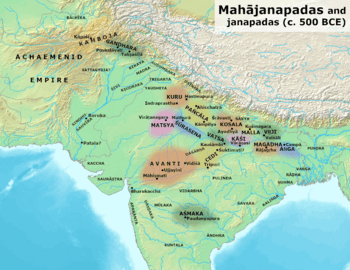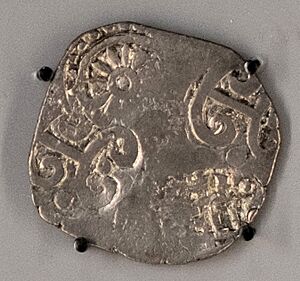Vatsa facts for kids
Quick facts for kids
Kingdom of Vatsa
|
|||||||||
|---|---|---|---|---|---|---|---|---|---|
| c. 700 BCE–c. 300 BCE | |||||||||

Vatsa and other Mahajanapadas in the Post Vedic period.
|
|||||||||
| Capital | Kauśāmbī | ||||||||
| Common languages | Prakrit Sanskrit |
||||||||
| Religion | Historical Vedic religion Buddhism Jainism |
||||||||
| Government | Monarchy | ||||||||
| Maharaja | |||||||||
|
• 8th century B.C.
|
Nicakṣu(first) | ||||||||
|
• 4th century B.C.
|
Kṣemaka(last) | ||||||||
| Historical era | Iron Age | ||||||||
|
• Established
|
c. 700 BCE | ||||||||
|
• Disestablished
|
c. 300 BCE | ||||||||
|
|||||||||
| Today part of | Allahabad division of Uttar Pradesh, India | ||||||||
Vatsa, also known as Vamsa, was an important kingdom in ancient India. It was one of the sixteen "Mahajanapadas," which means "great kingdoms." These kingdoms were powerful states that existed a very long time ago. Vatsa was located in the northern part of India.
Contents
Where Was Vatsa Located?
The Vatsa kingdom was located south of the great Ganges River. Its capital city was called Kauśāmbī, also known as Kosambi. This city was built along the Yamuna River. Today, you can find its ancient site near a place called Kosam.
The History of Vatsa Kingdom
Early Days of Vatsa
The people of Vatsa were part of the Kuru dynasty. The Kuru Kingdom was very large during the Rig Vedic period. It covered areas like modern-day Haryana, Delhi, and parts of the Ganga-Yamuna region. Its first capital was a city called Hastinapura.
Later, a big flood destroyed Hastinapura. The Kuru King, Nicakṣu, moved his people to a new capital. This new city was called Kosambi. Over time, the Kuru Dynasty split into two main groups. One group stayed in the northern areas. The other group, the Vatsas, settled in the southern parts.
The Vatsas later divided even more. One group settled near Mathura. The other group stayed in Kosambi. Ancient texts say that King Nicakṣu moved to Kosambi after the flood. He was an ancestor of the Bhārata family. The Puranas, which are old Indian texts, list his successors. The last king mentioned in this line was Kṣemaka.
Some stories say the Vatsa kingdom was named after a king from the Kaśī region, named Vatsa. Other ancient stories, like the Ramayana and the Mahabharata, say a prince named Kuśa founded Kosambi.
Vatsa as a Great Kingdom
The first important ruler of Vatsa was King Śatānīka II. He was a strong king. He married a princess from Videha. She became the mother of Udayana, a famous Vatsa king. Śatānīka II also married Mṛgāvatī, a princess from the Licchavi tribe. He even attacked Campā, the capital of the Aṅga kingdom.
Queen Mṛgāvatī, the mother of King Udayana, was a very important figure. She was the daughter of Chetaka, a leader from Vaishali. When King Śatānīka died, Udayana was still young. Queen Mṛgāvatī became a regent, meaning she ruled the kingdom for her son. She was known for being a wise and skilled ruler. She managed the kingdom so well that even experienced ministers admired her. Queen Mṛgāvatī is one of the earliest known female rulers in Indian history.
King Udayana's Reign
Udayana was the son of King Śatānīka II. He became a very famous king. Many stories and plays were written about him. He lived at the same time as the Buddha. He was also a contemporary of Pradyota, the king of Avanti.
The End of Vatsa Kingdom
After Udayana, a few more kings ruled Vatsa. These kings included Vahināra, DanḍapāṇI, Niramitra, and Kṣemaka. Eventually, the powerful Avanti kingdom took over Vatsa. A prince from Avanti, Maniprabha, ruled in Kosambi for a while.
Finally, the Vatsa kingdom was fully taken over by the Magadha kingdom. This happened during the rule of King Shishunaga of Magadha.
See also


